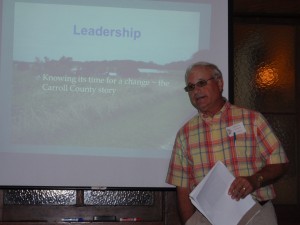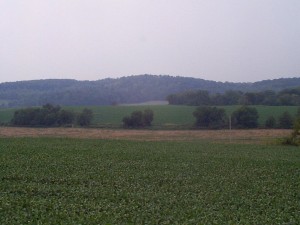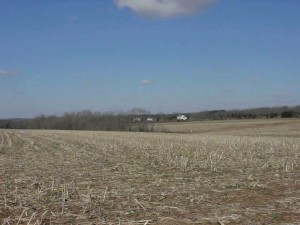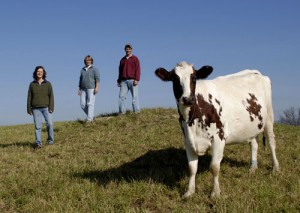Farmland preservation Roundtable 2012 meets in NJ

Roundtable 2012, l to r: Mike McGrath, Denise King, Jeff Swinehart, Brian Schilling, Ralph Robertson, Lavonne Paden, Jeff Everett
LAMBERTVILLE, NJ – Farmland preservation program administrators and others from Maryland, Pennsylvania, New Jersey, Ohio, Delaware and West Virginia met in this Delaware River town in Hunterdon County on Sept. 6 and 7 to get advice from their peers and discuss issues and topics of concern. Eighteen individuals attended the Roundtable 2012, organized by FPR publisher Deborah Bowers.
How to administer the first requests for the 25-year buyout clause contained in the Maryland, Pennsylvania and Delaware programs was a topic of discussion, with the first such requests received by the Maryland Agricultural Land Preservation Foundation (MALPF) in recent months, one from Howard County, involving large acreage and multiple parcels and one from Montgomery County. Maryland struck the 25-year buyout clause from its law in 2007, and Pennsylvania followed suit last year. But the change is not retroactive and programs are preparing to handle such requests from owners of properties preserved prior to the change who will pursue the buy-out claiming their land is no longer farmable. Local agricultural preservation advisory boards, state boards, and either legislative or gubernatorial approval are required by law before an easement would be released.
Mike McGrath, recently retired from directing the Delaware program, said the 25-year release clause serves the public interest and that as long as the land has a high value for agriculture, no property owner would be able to demonstrate it was not viable for agriculture.
First-time Roundtable participants included Brian Schilling, assistant professor of agricultural, food and resource economics at Rutgers University and assistant Extension Specialist of Agricultural Policy at Rutgers Cooperative Extension. Schilling’s research has been focused in recent years on farm viability in New Jersey, farmland preservation and ag economic development at the urban-rural fringe. He recently studied farmland valuation and affordability. Also attending for the first time was Denise King, executive director of the Ohio farmland preservation program, and Ralph Robertson, program manager of the Carroll County, Md. program.
Robertson provided the Roundtable’s first presentation, outlining his program’s innovation on the use of installment purchase agreements, which this year will pay easement sellers 5.25 percent tax free interest for 20 years on offers of 40 percent of appraised fair market value. The offer amount for each project is secured through purchase of a zero coupon bond. The high rate of interest doubles the offer amount at the end of the period, and was chosen by half of 32 applicants in the latest application round this Spring. The other applicants chose to receive lump sum payments. Robertson said he and former program assistant Jeffrey Everett, present at the Roundtable, devised the arrangement, referred to as a discounted, leveraged installment purchase agreement (IPA) several years ago when calculations revealed that continuing with traditional IPAs, which paid market rate interest over 10 or 15 years, would not attract the county’s best farm owner/operators and would take too long to reach the county’s goal of preserving 100,000 acres. In 2011, offering six percent interest on a 40 percent of FMV offer, the county preserved 4,598 acres. The interest had to be adjusted downward this year due to the cost of zero coupon bonds, Robertson said.
The installment purchase approach to preserving farmland was originated by Daniel P. (Pat) O’Connell now with Evergreen Conservation Finance, in 1989 for Howard County, Md. A number of local and state governments adopted the use of IPAs over the last 20 years including Harford and Frederick Counties in Maryland, Burlington County, NJ, and the City of Virginia Beach.
Most Roundtable participants representing state and local governments said their funding streams appear to be secure for the upcoming year despite the recession.
Jeff Swinehart of the Lancaster Farmland Trust (LFT) said his organization does well with challenge grants from Lancaster County, which have been in amounts of between $500,000 to $1 million “with no strings attached.” The LFT has ongoing corporate sponsors as well, including a local restaurant chain that donates a portion of sales of local-ingredient dishes to LFT, and from Turkey Hill, a Lancaster County ice cream manufacturer whose slogan “Imported from Lancaster County” boasts of the county’s reputation for bucolic scenery. Turkey Hill agreed that LFT’s work in preserving that scenery was worth a dedicated portion of their sales, amounting to about $50,000 annually.
Tom Daniels, FPR senior contributing editor and professor at University of Pennsylvania’s Department of City and Regional Planning said even government programs could be looking to private funds to support their efforts, and that private money from entities that benefit from preserved land could be the driver of land preservation in the future.

From left, Carol West, Jen Dempsey, Ben Kurtzman, Doug Wolfgang, Matt Knepper, Joy Levy, Ellen Dayhoff, Susan Payne
Doug Wolfgang of the Pennsylvania Bureau of Farmland Preservation said an attempt to divert his program’s $20.5 million in dedicated cigarette tax revenues to the state’s general fund during the legislative and budget session this year was itself diverted much to the relief of program proponents.
Carol West of the Maryland Agricultural Land Preservation Foundation (MALPF) said that program continues to lag from fund diversion. The program was established with a dedicated source of revenue from the state’s real estate transfer tax and an agricultural land conversion tax, but both sources have lost their status as dedicated streams and have been siphoned off by the legislature for the last six years. “Backfilling” the hole with bond funds that don’t match the amount taken has left the program board repeatedly opting to skip a program year in order to combine two funding years.
New Jersey is operating on ample bond funds approved by voters in 2009 and released by Gov. Christie this year and last. Susan Payne, executive director of the State Agriculture Development Committee, said the program this year will reach its 200,000-acre milestone. The program continues to struggle with uses on preserved farms allowed by the legislature, and violations that require legal action. One violation involved excavation that removed a hilltop to build greenhouses. Another involves a winery owner’s onsite promotional activities that pit the definition of agriculture against commercial uses.
Carol West said the Maryland program is struggling with violations involving subdivision of land, particularly properties that include multiple parcels. Under the law, owners must receive permission to subdivide, and remaining acreage must be 50 acres or greater. Doug Wolfgang of the Pa. program said a deed of merger at settlement could avoid subdivision problems.
Denise King said the Ohio program has benefitted greatly from the federal program, receiving the second highest amount of the funding from the Farm and Ranchlands Protection Program.
Matt Knepper, director of the Lancaster County Agricultural Preserve Board, said his program has $3 million in bond funding from the county commissioners and $2 million from the state this year. While a permanent source of dedicated revenue is desired at the local level, there is continued difficulty in identifying the source, he said. There are 200 farms waiting in the program, which has preserved more than 70,000 acres and had an average cost per acre of $2700 last year, down from the year prior.
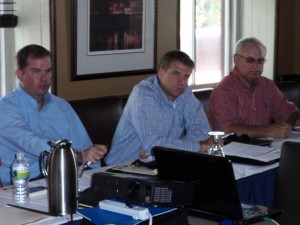
Brian Schilling of Rutgers, Brian Wilson of Burlington County, NJ, and Ralph Robertson of Carroll County, Md.
Lavonne Paden said the West Virginia program is supported by a recordation tax that brings in $800,000 yearly and is “very stable.” Of 55 counties, 20 have now created programs supported by the state-enabled local real estate transfer tax. Those county programs, along with the West Virginia Agricultural Land Protection Authority, have preserved to date 17,129 acres. In 2011, $3.4 million was spent on easements.
Mike McGrath presented Delaware’s new Young Farmer Program that provides no-interest loans to farmers between 18 and 40 to purchase a farm in Delaware with at least 15 tillable acres and zoned for agriculture. The assistance will pay 70 percent of easement value up to $500,000 in the form of a 30-year loan.
Jennifer Dempsey of the American Farmland Trust presented an outline of how the farm bill will change how the NRCS assists with the cost of easements. The farm bill will merge the former Farm and Ranchlands Protection Program with the Grassland Reserve Program to create the new Agricultural Land Easements (ALE) program. Changes that limit federal involvement in acquisitions and valuation are expected to improve collaboration with localities and land trusts.
Roundtable participants spent two days exchanging ideas and aiding each other with advice and ideas on solving problems and addressing issues.
The group also heard from Steve Finn and Jane Magne of the Bucks County Foodshed Alliance that works to promote use of local foods, some of which comes from preserved farms. Bucks County, across the Delaware River from Hunterdon County, has preserved about 12,000 acres.
Survey shows $4 billion spent by top state programs
BY DEBORAH BOWERS, Editor & Publisher
2012 Farmland Preservation Program Costs[PDF]
The nation’s leading state-operated farmland preservation programs have preserved more than 1.4 million acres and 11,530 farms at a cost of about $4 billion since these programs first began operating in the early 1980s, according to a survey conducted by FPR. The survey, conducted in Aug. and Sept., looked at states in New England and the Mid-Atlantic, including Ohio, which purchase development rights from willing farm owners, and retire those rights in an effort to preserve local agriculture and open space.
Maryland and Massachusetts were the first states to develop programs, both enacting legislation in 1977 that established purchase of development rights as a government function. The protection of farmland became a mission and goal of the state in the absence of effective or adequately protective zoning at the local level. Programs are voluntary and pay farmers in per-acre amounts that represent the difference between the appraised fair market value of their land, and the value of that land for agriculture. Protection is in the form of a deed of conservation easement that runs with the land in perpetuity. Land remains in private hands and on tax rolls.
Farmland loss due to sprawl was first noted as a local problem on Long Island, NY, in the 1960s and a program to purchase easements was developed there in 1974 in Suffolk County in an effort to save its remaining agricultural industry. At extraordinary cost, the county has preserved about 6,000 acres.
After Maryland and Massachusetts adopted the conservation easement as the method for preserving agricultural land, other states followed suit, many adopting many aspects of the Maryland or Massachusetts laws. Those included all states along the Eastern seaboard from Maine to Virginia, and to other states such as Ohio, Kentucky and Michigan. The survey includes only those states with programs that are active, funded and comparable in operation to Maryland’s. The survey excludes programs in the West in such states as California and Colorado.
Following are summaries, with links, of the state farmland programs included in the survey.
Connecticut
The Connecticut program has preserved 38,600 acres and 283 farms. In 2010, the state preserved 15 farms and 1,228 acres for $5.6 million, according to the program’s annual report. After a period of virtually no funding due to a reluctant bond commission, for a number of years now the Connecticut farmland preservation program has been budgeted to receive $10 million in bond funds as well as about $1 million from a statewide recordation fee that in 2010 alone paid for preserving six farms.
While it is the third smallest state in the U.S., Connecticut’s agricultural industry, according to a 2010 UConn study, has an economic impact of $3.5 billion when including its $1.7 billion “value added” segment. The study may have given some steam to a new program, connected to the farmland preservation program and inaugurated in 2011 – the Farmland Restoration Program. This program was created to spur local food production with grants of up to $20,000 for such projects as restoring overgrown or unused pastures and cropland to productive use, including removal of invasive vegetation and hedgerow management. Installation of fencing – for keeping livestock or for excluding wildlife – and restoring stream banks are also eligible projects. Grant funds are in the form of reimbursement for approved costs.
The Connecticut program has set a goal of preserving 130,000 acres, as long as at least 85,000 of those acres are cropland. The program states on its website: “This land base will enable Connecticut to produce at least 50% of its fluid milk needs and 70% of its in-season fresh fruits and vegetables. This in-state production will ensure some degree of local availability of fresh farm products. It will also help ensure related jobs and remain an important part of the State’s economy.”
Farmland makes up about 13 percent of the state’s land mass, and its 4,916 farms (average size of 82 acres) rank first in New England in terms of market value per farm and per acre, according to the UConn study. The program is administered by veteran director Jay Dippel.
Maryland
The Maryland Agricultural Land Preservation Foundation (MALPF) has preserved, since 1980 when the first easement was purchased, 279,223 acres on 2,043 farms. The MALPF program is governed by a 13-member board of trustees that oversees grants to counties, but not all counties are equal. Those that gain certificationaccording to state guidelines are authorized to retain 75 percent of the state agricultural conversion tax collected within their boundaries to use for farmland preservation, using their own program or partnering with the state program. Those that are not certified retain 33 percent.
But these revenues may or may not be enough to support a county’s preservation agenda without the state’s matching funds, and that has been anything but certain in its recent history. While some counties in a given year have more money allocated to farmland preservation than the entire state fund, others have zero preservation dollars.
The state program’s funding has been hard hit by a legislature and successive governors who see its supposedly dedicated real estate transfer tax revenue stream as a way to help prop up Maryland’s continually ailing, though Triple-A rated, fiscal condition. Since about 2003 the program has been robbed of its purse strings, leaving its money available for the taking for the state’s general fund, including, at times, funds that were allocated but not yet spent. The MALPF staff of seven often struggles to keep up with policy and legislative changes and funding adjustments, as well as monitoring and enforcing its more than 2,000 easement properties. The program has a strained relationship with some of its county-level program partners due to changes in policy and regulations, and often the interpretation of these.
Some counties have benefitted from local leadership more than others. Carroll County, which ranks 4th in the nation for number of acres preserved (62,000+) was out in front early in the program, and has long had the largest percentage of acres preserved under MALPF, at nearly 15 percent. Carroll is followed by Caroline County, on the Eastern Shore, with 11 percent, although Caroline does not have a certified local program. The next highest percent is Baltimore County, which is certified, at almost 8 percent.
Massachusetts
When the Massachusetts legislature created a farmland preservation program in 1979 it called it the Agricultural Preservation Restriction (APR) Program. Along with Maryland, it is the oldest state farmland preservation program, but has preserved just 80,000 acres to date, and 800 farms. But with a New England climate, agriculture is something to be coddled, and preservation eligibility criteria seem to reflect this – an owner needs just five acres to apply for easement sale, compared to 50 acres in Maryland (formerly 100 acres). The Massachusetts program also reflects a tenacity to hold on to agriculture and to help the industry succeed on its own terms. For example, the Farm Viability Enhancement Program that was launched in 1996 focuses on boosting farm profitability with technical assistance and business planning and grants for investing in equipment or infrastructure, and then pays for term easements, called covenants, of from five to 10 years, with payments ranging from $50,000 to $100,000 for varying production levels. Since its inception the program has awarded grants, with covenants, to 337 farms. Grants pay for such improvements as new or enlarged farm produce stands, dairy barns or processing plants, new or used equipment or sheds.
The cost of permanently protecting land from development in Massachusetts is rivaled only by New Jersey, at an average cost in 2011 of $11,487 per acre.
New Jersey
After nearly 30 years of funding the purchase of development rights through real estate boom and bust years, preserved farmland in the nation’s most densely populated state is reaching the notable milestone of 200,000 acres preserved. Farmland preservation in New Jersey has always been funded through bond issue, and voters have consistently supported farmland and open space preservation at both the state and local level, either through bonds or open space taxes, the last in 2009. Gov. Chris Christie put off appropriating the borrowed funds that voters approved, but eventually did sign bills that released the funds. Last year he signed appropriation bills that secured $90.6 million for farmland preservation acquisition projects for both state and local-level acquisition. State-level acquisitions by the State Agriculture Development Committee (SADC) have $19.7 million allocated and there is $39 million for grants to 16 participating counties to preserve farmland, consisting of a $1.5 million dollar “base grant” to each county and a $15 million competitive grant fund. Counties use their base grants and then compete for additional grant funds until the money is exhausted. Any county can qualify for up to $3 million in competitive grants, for a potential total maximum combined grant of $4.5 million. In addition to the county level funding, $23 million is available in grants to participating municipalities. Last but not least, $8.8 million is available in grants to eight nonprofits that preserve farmland this year, the largest fund yet made for land trusts by SADC. The SADC program and its 30-plus employees are led by Susan Payne, executive director since 2005, whose prior experience leading the Burlington County program put her in a good position to build optimum working relationships with county programs. The SADC operates a number of programs in addition to farmland preservation that aid agriculture in the state.
One of SADC’s programs that is unique among state farmland preservation programs is its emergency fee simple option for farms that must be sold. SADC buys the farm, places the deed restriction on it, and resells, at auction, to a bonafide farmer.
SADC has been involved in a number of cooperative projects over the years involving multiple agencies, including a large project concluded in August on the 1,900-acre former Princeton Nurseries property in the center of the state. The $28 million agreement used more than $16.5 million in state, local and nonprofit open space funding for the fee purchase of 512 acres to become a state Wildlife Management Area and nearly 500 acres as additions to the Monmouth and Mercer County park systems. The SADC and its county and local partners provided another $11.4 million to purchase farmland easements on an additional 847 acres.
New York
New York’s farmland protection program has two funding channels– one to local planning for farmland protection and the other to implementing those plans. Planning grants are available for counties to cover up to 50 percent of the costs to develop agricultural and farmland protection plans. Several grants of up to $50,000 each are awarded on a rolling basis each year to counties that apply. The program has awarded over $2 million in planning grants to 48 counties. For purchase of development rights, the program has awarded nearly $80 million to protect approximately 36,000 acres on 200 farms in 18 counties, according to the program website.
The program over its history has had difficulty getting localities to complete projects once approved. A 2010 comptroller report found that no funds appropriated over the prior two budget cycles had been encumbered and that only half of the funds appropriated in 2008-09 had been encumbered.
According to Farmland Protection Program manager David Behm of the NY Dept. of Agriculture and Markets, as of Nov. 2012, 22 localities with awards amounting to $19.4 million, have not provided necessary documents, such as title commitment, deed of easement, and monitoring plan, to close on projects. They have until mid-January 2013 to do so, he said, or funding may be withdrawn.
Unlike other programs, the State of New York is not a grantee on a deed of easement under its program, and retains no interest in the property. Therefore, the program has no stewardship or monitoring role.
Ohio
Ohio has preserved, in its first 10 years, 311 farms, comprising more than 54,143 acres, almost 12 percent of those acres through easement donation. The Ohio program controls costs by paying up to 75 percent of a points-based appraised value of a farm’s development rights. A payment cap is set at $2,000 per acre, with a maximum of $500,000 per farm.
The Agricultural Easement Purchase Program (AEPP) is the farmland preservation component of the Clean Ohio Fund bond initiative, which was originally approved by Ohio’s voters in 2000, who gave a thumbs up to continue the program with another bond issue in 2008. However, as in other states, no grant funds were appropriated from bonds for FY 12, but a one-time allotment of FRPP program funds was allocated, and in 2011, 38 easements were closed, preserving 6,470 acres in 19 counties.
To further encourage easement donation, last year the program added the Agricultural Easement Donation Partnership Program, which reimburses local partners (counties, townships, Soil and Water Conservation Districts, or land trusts) for real estate closing and administrative costs when receiving donations under the state’s farmland preservation program. The department has set aside $50,000 to cover up to $3,000 in costs for the donation of farms up to 200 acres. The incentive would increase by $5 per acre for easements on farms of more than 200 acres. Funds will be equally available in all areas of the state.
Pennsylvania
The Pennsylvania farmland preservation program was launched a full 10 years after Maryland’s, but about five years ago its tally of preserved acres overtook the Maryland tally due to a steady and truly dedicated funding stream (save this year’s legislature’s attempt to divert those funds). In the not too distant future the program will reach the half-million acres milestone.
The program is administered by the Pa. Dept. of Agriculture’s Bureau of Farmland Preservation and is funded through a flat appropriation of $20.5 million per year from the cigarette tax in addition to funds from a bond fund that in 2011 provided $5.11 million. Total funding in 2011 was $36 million, including federal, state, county and local dollars. Of the 57 counties eligible to participate in the program, 53 appropriated $16.5 million in local matching funds for the 2011 calendar year.
Some Pennsylvania counties operate independent programs but most need state direction and oversight. Lancaster County is the state’s most noted local program and ranks as the No. 1 local program in the nation, with more than 90,000 acres preserved, including those preserved through a cooperative agreement with the nonprofit Lancaster Farmland Trust.
The most active county programs, not surprisingly, are in the southeastern quadrant of the state, where development pressure comes from the Philadelphia region, Maryland and New Jersey.
Like Maryland, the Pennsylvania program recently erased from its law the possibility for preserved-farm owners, after 25 years, of buying back their easement by claiming their land can no longer be farmed. The change, however, does not affect the easements purchased prior to the law. Maryland has recently received two such claims, and the Pennsylvania program will reach its 25-year anniversary in 2014.
Vermont
Vermont combines the private nonprofit sector with its state operated land preservation program like no other state, funding land preservation through its Housing and Conservation Board (VHCB) and working with the Vermont Land Trust (VLT) to carry out the easement process. To date, Vermont has preserved 170,000 acres, the most by far of any New England state, and at a cost of just $1,520 per acre average. Vermont’s Farmland Conservation Program in its most recent round combined agricultural preservation with riverbank conservation, making a number of easement purchases on farms with a combined 8,000-plus feet of river frontage. In May 2012 the VHCB, which oversees the program, committed $1.48 million in state allocated funds to match a federal Farm and Ranchland Protection Program grant of $1.92 million. This was enough to complete conservation easements on 13 farms and 2,112 acres. The farmland preservation program is supplemented by a Farm Viability Program that provides grants for entrepreneurial projects or farm operation upgrades, for example, helping a dairy with equipment purchases or building renovation to add a cheese making facility. VLT has preserved 2,100 acres and 21 farms in addition to the state tally.
Virginia
The Virginia Farmland Preservation Program has preserved 5,525 acres and 41 farms since enactment in 2000, a notable minor contribution to the state’s broader land preservation effort to receive easement donations in exchange for ample state tax credits. That effort, carried out mainly by the Virginia Outdoors Foundation, has resulted in about 900,000 acres of open space and farmland preserved via donated easements, about two-thirds being held by VOF.
Virginia was late in adopting PDR for farms and farmers who had little to benefit from income tax credits and has spent little on it compared to other states –$12.3 million to date.
Twenty-two local PDR programs exist in Virginia, 18 of which have had some level of local funding available over the past few years. Shenandoah and Washington Counties are receiving state matching funds for the first time. This year is only the fifth time the state has provided matching funds for local PDR programs. A total of $6.45 million has been allocated since Feb. 2008.
West Virginia
West Virginia’s program was enacted in 2000 and farms are preserved by a state authority as well as by local Agricultural Protection Boards. Local boards were authorized to levy real estate transfer taxes to support their farmland efforts, and this has kept the protection effort steady if not growing notably. In the 10 years since the West Virginia Agricultural Land Protection Authority was established, and county boards continued to be formed, the state and local efforts combined have preserved 17,129 acres and 141 farms, many of those in the state’s Panhandle region.
